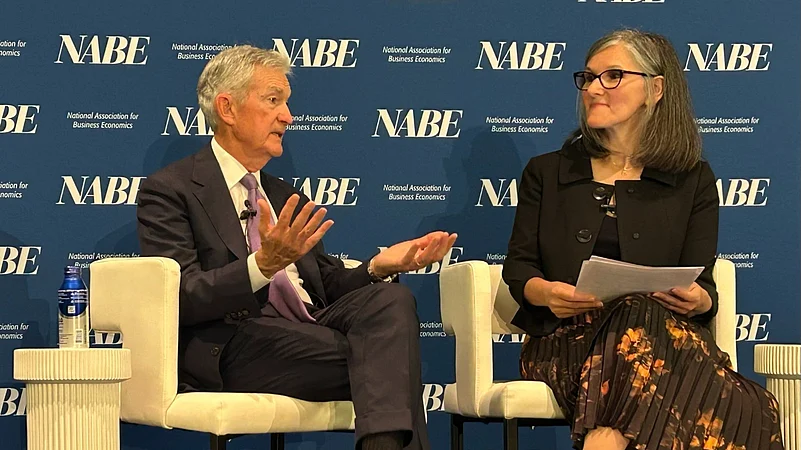US Fed Chair Jerome Powell signaled a possible interest rate cut at the upcoming October FOMC meeting, citing downside risks to employment and inflation targets.
Labour market concerns are growing, with job creation slowing and unemployment ticking up to 4.3% in August and holding steady in September.
The ongoing US government shutdown is disrupting key economic data releases, making it harder for the Fed to assess the economy ahead of its policy decision.
Markets now expect a 25 basis point rate cut, with a 95.7% probability priced in, as per CME FedWatch data.
US Federal Reserve Chair Jerome Powell on Tuesday signaled another interest rate cut at the next Federal Open Market Committee meeting. Powell hinted at the need for another reduction in benchmark lending rates during his keynote speech at the National Association for Business Economics conference in Philadelphia.
At a time when global markets are rattled by US President Donald Trump’s tariff policies and a US government shutdown, investors are keenly looking forward to addresses by Fed governors to get more insights into the Fed’s rate outlook and the health of the US economy.
Powell’s speech comes just two weeks ahead of the next FOMC meeting. At his keynote address on Tuesday, Powell highlighted the downside risk to the US central bank’s dual goals of full employment and low inflation.
Weakening Labour Market May Prompt Rate Cuts in October
In his latest remarks, Powell said that while unemployment remains on the lower side, the slow pace of job creation may hinder the stability of a steady jobless rate. He also said that inflation continues to run above the Fed’s target of 2% but is likely to ease after a temporary boost from tariffs.
“You’re at a place where further declines in job openings might very well show up in unemployment,” Powell said. “You’ve had this amazing time where you came straight down, but I just think you’re going to reach a point where unemployment starts to go up.”
The minutes of the September 16–17 FOMC meeting showed that Fed policymakers described the outlook for the labour market as "uncertain" and viewed downside risks to employment as having increased over the intermeeting period.
Fed funds futures traders now see a 95.7% probability of the Fed reducing the fed funds target range by 25 basis points to 3.75–4.00% at its October 29 policy meeting, according to the CME FedWatch tool. The Fed cut its target range to 4.00–4.25% in September, marking its first cut since December.
The unemployment rate ticked up to 4.3% in August and remained unchanged in September. However, the initial jobless claims data for the week ended October 4 showed that the number of Americans filing new applications for unemployment benefits rose to a seasonally adjusted 235,000 from 224,000 the week prior, according to calculations by JPMorgan and Goldman Sachs. Official unemployment data collection and publication has been suspended due to the government shutdown.
US Govt Shutdown May Complicate Fed Outlook
The US government shutdown came into effect on October 1, for the first time in seven years, after Republicans and Democrats failed to resolve a budget stand-off. The shutdown has affected possibly all sectors and is disrupting government operations in October. White House Press Secretary Karoline Leavitt told reporters that layoffs among federal employees would be “imminent.”
According to a Bloomberg report, the absence of official economic data has raised worries among Fed officials that they won’t get a clear read on how the economy is shaping up, possibly risking a miscalculation while making policy shifts. Powell said he and his colleagues are looking at alternative, private-sector data sources but stressed the credibility and importance of government data, which he called the “gold standard.”
“We’ll start to miss that data, and particularly the October data. If this goes on for a while they won’t be collecting it, and it could become more challenging,” Powell said.
Market participants are now looking forward to the release of the latest US jobless claims data, producer price index (PPI), and retail sales data for September, due Thursday. Investors will also closely assess key speeches by Fed Governors in the coming days to gauge the Fed’s rate outlook.



























